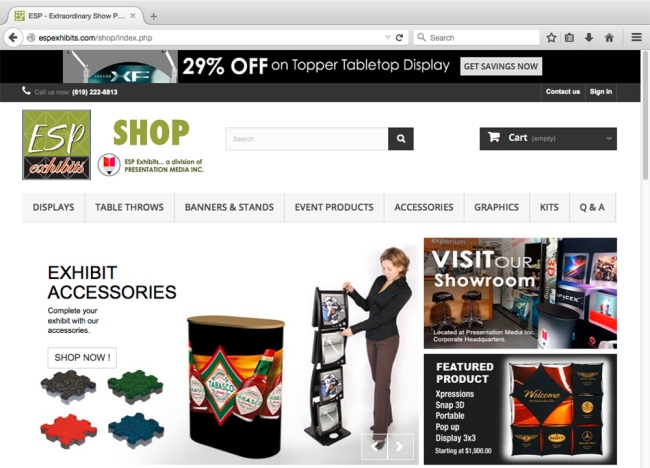Trade shows are an important part of marketing your company, and the contacts and impression you make at a trade show can be critical to your success. There are some basic steps to consider for making the most of your trade show experience. Click the link below to learn more.
How to Plan for a Tradeshow: Trade Show Basics by ESP
http://www.espexhibits.com
Trade show basics by ESP helps you with all the steps to plan a successful tradeshow exhibit with tips on exhibit.
Timeline
Begin with creating a timeline that will help you avoid last-minute rush charges and lost opportunities. There are a number of software packages available specifically for project management. Or, you can just use a simple spreadsheet or word processing program. Use this Trade Show Preparation Timeline as a guideline in developing a schedule tailored to your trade show participation.
For organizational purposes, it is nice to create a notebook divided into sections, including budget, shipping information, trade show services, graphics, promotions, travel logistics, and miscellaneous information.
Strategy
Research the trade show. Review who will be attending as well as the trade show’s history. Many trade shows begin their space reservations before the previous show closes. Visit the show’s website. The majority of trade shows are available for exhibit booth space signup through the Internet.
Sign up as soon as you make the decision to participate – this could prevent late signup costs. Most trade show organizers will ask for an initial deposit to confirm your booth space and then provide you with the due dates for additional payments.
Determine who will be part of your exhibit team which may be both internal and external personnel. Setup a meeting with your team and determine their assignments and deadlines.
A handy method for keeping track of each task is to jot down on your calendar each task per specific date and follow-up when you turn to that date. You also should determine exhibit design, promotions, lead handling processes, staffing and logistics.
Exhibit Design
It is important to have an idea what you would like for your exhibit design, meet with other members of your marketing/sales department and determine what your message should be for this trade show. If you will be building or renting an exhibit, planning should begin at least three months in advance. If you are going to be using structure already available and making minor or no modifications to existing booth graphics, this can be done in about a month.
Promotion
Trade show organizers will allow you to rent prior years’ attendee lists as well as the current year’s pre-registered attendees. With these lists, you will be able to send notices of your trade show participation as well as the exhibit booth number. Additional promotional strategies also are provided by show organizers and should be included in your exhibitor-services manual.
This also is a good time to determine what promotional giveaways and literature to handout during the show. Add this to your time schedule.
Lead Handling and Collateral
Work with your marketing/sales team to determine what information you will want to obtain from attendees. Decide whether you will use an electronic or manual system for retrieving leads during the trade show. You should also determine what your post-show lead fulfillment plan would be. This should be done about three months prior to the show.
Staffing
Decide who will be attending the trade show and staffing your booth as soon as possible in order to communicate any show particulars and share your show strategy. You will need these names to order exhibitor badges as well as providing the staff information on show dates, location, conference registration, hotel accommodations, and air and ground travel arrangements.
Installation and Dismantling (I&D)
Determine who will be installing and dismantling your booth well in advance of the trade show. Estimate how many hours it takes and the dates you will be setting up and tearing down your booth. Provide this to the show organizers by completing the paperwork located in the exhibitor-services manual. This should be done about 30-45 days prior to setup.
Shipping
Determine what you will be shipping to show i.e. structure, equipment, display hardware, giveaways, literature, and supplies. This will help you decide what type of carrier you should use – van line or air freight. Provide the pertinent trade show information to your carrier and they will determine when your shipment should be ready for transport. Make your return shipping plans with your carrier at the same time.
The return shipment date can be determined by referring to the trade show teardown date and scheduling the pickup for the day after show closing. This should be done at least two months prior to the show.
On-site Services
When you receive your exhibitor-services manual, all of the on-site services deadlines will be identified such as: material handling, carpet rental, furnishings, floral arrangements, cleaning, electrical needs, and computer equipment rental. Order online or complete the paperwork for each service you will be using. Normally, there is a discount for providing this information early.
At the Show
Prior to the trade show, make a list of details to be completed at the show including: picking up badges, confirming you have received all items ordered, ensuring your shipment has arrived, supervision of exhibit installation, pick up lead retrieval systems and blank bills of lading.
Show Close
Dismantling usually begins as soon as the show closes although not in all cases. This information can be found in your exhibitor-services manual. It is usually the time you return your lead retrieval system as well as audio visual and computer equipment. Normally, the floral will be yours to keep; however, plants ordered are typically on a rental basis and will be picked up by the floral company. The furnishings also will be picked up soon after show closing.
Exhibit dismantling sometimes can be started immediately upon show closing although some trade show organizers may wait until the next day. The repackaging of your exhibit is done after dismantle and, at that time, the completed bill of lading should be turned into the exhibitor services center. If you do not submit your bill of lading, your shipment will not be released to your designated carrier but rather it will be sent via the shipper of choice of the trade show contractor company.
Post Show
The trade show is over and it has been a success! Now is the time to turn leads over to the appropriate sales people; submit a personal expense report; work with the exhibit house to inventory the exhibit and determine necessary repairs; review final show invoices and finalize show budgets. ESP can help you with any of the above details. We are ready to help you with our range of products, advice and experience for successful trade show participation.
Your First Trade Show
Advice for your First Trade Show Display
If this is your first time at a trade show, you are possibly a little bit nervous about how the event will unfold and if you’ve forgotten anything in organizing your display.
This is one of the advantages of dealing with ESP – a company that can help you every step of the way. We’ve seen all kinds of trade shows and displays and there is little for which we can’t provide either some advice or a definitive answer.
But let’s go back to the beginning for a moment and speak to those who are just beginning to think about their first display.
What are the criteria for your first trade show display?
Price
Either you’ve put together a budget yourself, or you’ve been given one by your company. In any case, the total cost of your trade show display is a determining factor in what you should be looking at.
- If your budget is under $5000.00, you should consider portable tabletop displays, freestanding popup displays such as SALESMATE presentation displays, XpressionsSNAP 3D popup displays, VBURST! stretch fabric popup displays, classic popup displays with Velcro-friendly fabric panels or mural graphic panels, folding panel display packages, or banner stands.
- More elaborate portable displays and simple modular display systems or possibly a combination of these display types usually fall within the budget range of $5,000.00 to $10,000.00.
- If you have more to play with, say between $10,000.00 and $30,000.00, you should be looking at simple to slightly customized modular display systems and full custom displays depending on the size of your display booth and the image you want to portray.
- And if price is no object, then you should consider custom modular display systems and full custom exhibits. Note that custom exhibits can be modular to a degree although they usually don’t have the same flexibility as modular display systems and are often heavier and bulkier resulting in higher shipping and show site drayage costs.
Combining display types is an option to help you meet budget objectives. For example, you can combine a tabletop display or a freestanding portable popup display with a banner stand. Or you can use three banner stands to create a 10’w display backwall in your exhibit booth space.
Also, popup displays can be combined with modular display systems to help meet budget restrictions. The possibilities are virtually unlimited.
Space
- If your trade show booth space is linear (in a line with several other exhibit booths), your display is usually restricted to a height of 8′. While any display type can be used in a linear space, the most common are freestanding popup displays such as classic pop ups, XpressionsSNAP 3D popup displays, VBURST! stretch fabric popup displays, folding panel display systems and tabletop displays. Multiple banner stands are also frequently used to create a linear booth space backwall.
- For island and peninsula (also known as end cap) exhibit booth spaces, the typical display is either a modular panel system or a custom exhibit. Although less common, portable popup displays are also used in island and peninsula spaces.
Multiple story displays are almost always custom exhibits or a combination of custom and modular display systems.
Portability
If you’re looking for the best in portability and convenience; if your ideal trade show display is something you can transport and set up yourself or ship inexpensively, you should be looking at portable tabletop displays, freestanding popup displays, and banner stands.
These portable displays are lightweight and usually can be transported by car, plane, or via express shippers.
If you want an idea of how the preparation for a trade show should look, take the time to read our Trade Show 101 section.
And don’t forget, if you’re confused at all or feel overwhelmed while planning your first trade show display, please feel free to call 619-222-8813 or contact us anytime for advice.
http://www.espexhibits.com/trade-show-planning.php
 New ESP Store Website Coming Soon!
New ESP Store Website Coming Soon!





